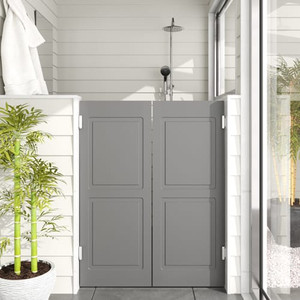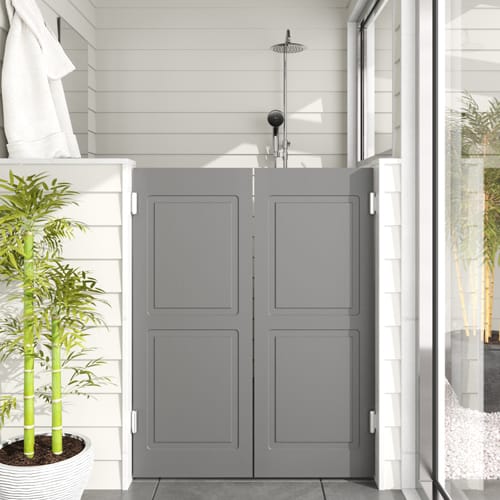
Revamp Your Space with Stylish Swinging Cafe Doors
Innovative Materials for Interior Doors: Redefining Home Aesthetics
In the world of interior design, every element within a space contributes to the overall look and feel. Often overlooked, interior doors play a crucial role in separating spaces, reducing noise, and contributing to the home's style. While traditional door materials like wood, glass, and metal have long dominated the market, a quiet revolution is underway in the door industry. Cutting-edge materials are paving the way for new door designs that not only look great but also offer innovative benefits in durability, sustainability, and functionality.
Traditional Touchstones: Wood, Glass, and Metal
For centuries, interior doors have been crafted from wood, providing homes with warmth and character. The versatility of wood allows for a wide range of door styles, from classic paneled designs to sleek, modern profiles. Glass doors, with their transparency and light-transmitting properties, have become synonymous with open-plan living and a classic, airy aesthetic. Metal, often associated with industrial and contemporary spaces, adds a touch of drama and sophistication to interior door design.
The Emerging Vanguard: Revolutionary Door Materials
More and more, homeowners and designers are seeking out materials that are both innovative and sustainable. Here, we explore some of the emerging materials that are reshaping the future of interior door design.
Composite Materials: The Best of Both Worlds
Composite doors, constructed from a blend of materials, most commonly including uPVC, foam, and wood, offer the best qualities of each to ensure a high-quality door. These doors are engineered for stability and resistance to warping and shrinking, making them ideal for high-traffic areas. They also excel in energy efficiency, providing superior insulation compared to their traditional counterparts.
Sustainable Options: Beauty with a Conscience
In an age where environmental concerns are at the forefront, sustainable materials such as bamboo and reclaimed wood are gaining popularity. Bamboo, known for its rapid growth and renewable properties, is a durable and elegant alternative to traditional wood. Reclaimed wood offers a rich history and rustic charm, having been salvaged from older structures, giving each door a one-of-a-kind appeal.
Smart Materials: Doors of the Future
Imagine a door that could open by itself, or one that adapts to changing lighting conditions to optimize energy usage. Smart materials in interior doors present not only a technological marvel but a new level of convenience and longevity. These doors and hinges are designed to interact with their environment, responding intelligently to the needs of the homeowner.
The Advantages of Innovation
The adoption of these new materials in door design is not without merit. They offer several advantages over their traditional counterparts, which can greatly benefit homeowners and designers alike.
Increased Durability and Performance
Innovative materials are often engineered to be more durable and resistant to wear and tear. This durability translates to longer door lifespans, reduced maintenance, and the preservation of aesthetics over time.
Eco-Friendliness at the Forefront
Sustainable materials contribute less to our environmental footprint. Innovative interior door materials harness the power of renewable resources and recycled content, aligning with the growing demand for green building practices.
Unlimited Design Versatility
New materials open the door, so to speak, to a world of design possibilities. They can be molded, textured, or finished in ways that traditional materials cannot, allowing for unique and custom door designs that suit any interior style.
Application Examples: Innovative Doors in Real Spaces
To truly appreciate the impact of these innovative materials, it helps to see them in action. Here are a few examples of how these materials are being used in real-world interior door projects.
Sustainable Stories: The Bamboo Bi-Fold
Transform a living space with a bi-fold door made of sustainable bamboo. Its warm, honey tones and contemporary lines are a testament to the beauty and possibilities that eco-materials bring to the table.
Selecting the Right Material:
When choosing the material for your interior doors, it's essential to balance practicality with aesthetics and budget.
Practical Cost-Effectiveness
Consider the upfront cost as well as the long-term value. While innovative materials may come with a higher price tag, their durability and performance may result in cost savings over time.
Maintenance Musts
Different materials require different levels of maintenance. Factor in how much time and effort you're willing to invest in door upkeep, and choose a material that aligns with your lifestyle.
Aesthetics and Longevity in Harmony
Ultimately, the look of the door will play a significant role in your selection. Choose a material that not only looks good now but will continue to do so as trends and tastes evolve.
In Conclusion, The Future Door is Here
Interior doors are more than just functional dividers—they're an integral part of your home's design story. From the materials used to the style and finish, each detail contributes to the narrative of your space. By exploring and embracing innovative materials, you can open new doors—literally and figuratively—to a future of sustainable, stylish, and resilient home design. The choices you make today can redefine what it means to create a truly timeless interior.
The home door market is experiencing a revolution of materials, with sustainability and function driving this change. For anyone involved in shaping living spaces, from interior designers to eager DIY enthusiasts, the innovative materials available for our interior doors provide an opportunity to rethink the very fabric of our homes. With the right choice, you can not only improve the aesthetic appeal of your interiors but also make a positive impact on the environment and your everyday life. As technology and design continue to intertwine in our domestic spaces, the interior doors furnishing our homes are set to become smarter, more eco-friendly, and more innovative than ever before.
